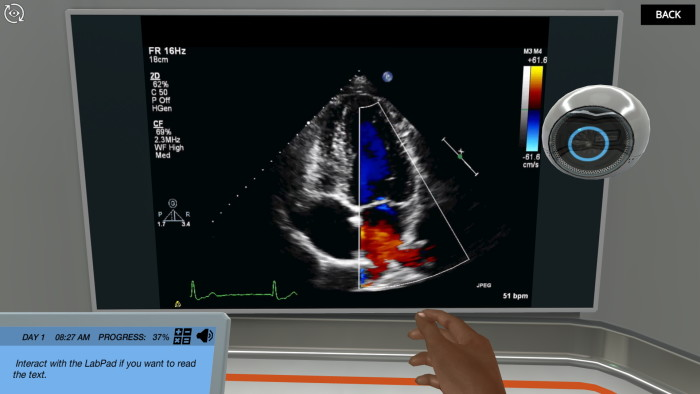
Doppler echocardiography is one of the foremost techniques available for cardiac health monitoring. It shows the speed and direction of blood flow by using high frequency sound waves. This technique represents an amalgamation of physics and biology, which makes it more complex to understand.
Thus, educators must develop innovative, engaging methods to teach echocardiography and its applications to students. Here, we list five creative ways to teach echocardiography to help students learn its theoretical as well as practical aspects.
Using interactive models to teach experimental and diagnostic techniques helps students visualize the outcomes of the techniques in real time. This visualization enables a stronger grasp of the subject matter. At the same time, it develops a deeper understanding of how to apply the techniques in real life.
Interactive models to teach echocardiography could take several forms. For example, in Labster’s ‘Introduction to Echocardiography’ simulation, students visualize blood flow in a virtual heart while using echocardiography. They also get to learn the underlying physics that makes the technique possible. Further, the students apply the technique to diagnose a virtual patient with a systolic murmur.

Games and activities in education help strike a balance between theory and experimentation. They make learning exploratory, revelatory, and awe-inspiring, which strengthens the students’ knowledge base. Thus, educators should consider using games and activities to teach topics like theory-intensive and application-oriented topics like echocardiography.
For example, you can take your students to a cardiologist who can demonstrate Doppler echocardiography on one of them. Alternatively, you can invite the cardiologist to your classroom where students can explore the components of a portable echocardiography machine. During the demonstration and exploration, you can explain the theoretical aspects of the technique. The students will find it easier to reconcile theory and experimentation in this manner.
Using technologies like simulation and animation in education facilitates hands-on training in a virtual environment. Gaining experience in a virtual setting is a worthwhile step towards developing the confidence and understanding to apply a subject in real life.
For example, Labster’s ‘Introduction to Echocardiography’ simulation allows students to practice Doppler ultrasound imaging on a giant virtual heart. The students can use this virtual heart to practice the different ultrasound transducer positions and angles in echocardiography. Optimizing the positioning and angling is necessary to correctly visualize different cardiac structures, something for which beginners need intensive training. Our simulation allows students to repeat this training as many times as they want to be comfortable with the technique.

Discover Labster's Echocardiography virtual lab today!
A classroom should be a safe space where students can also discuss their professional aspirations and expectations. One step towards building this safe space is to assist your students in their exploration of career opportunities. As educators, this can benefit you too. When you connect your subject to its implications in various professional roles, students will become inspired to study harder.
When teaching echocardiography to your students, inform them how cardiologists use it on a daily basis to diagnose heart-related problems. Tell them how cardiovascular surgeons use echocardiography before and after a surgical procedure to assess patient health. Discuss how medical researchers use this technique when evaluating the effects of a treatment on cardiac function.
In a hospital (or any healthcare facility), different fields of science interact with one another for the benefit of humankind. Thus, a hospital in itself represents a plethora of real-world applications of the science we learn in the classroom. When teaching a diagnostic method such as echocardiography, leverage the hospital setting to inform your students about its real-world applications.
For example, talk to your students about how echocardiography helps diagnose congenital heart defects and heart valve disorders. Tell them how this technique helps in monitoring the cardiac health of pregnant women at risk of cardiovascular disease. Inform them of the importance of echocardiography in emergency medicine when cases of acute heart failure or heart attacks arise.
Echocardiography is a complex, interdisciplinary technique that has immense use in healthcare. The creative methods we have discussed here can make this diagnostic method exciting and easier to apply for students.
Try our free 30-day All Access Educator's Pass today and teach with the Echocardiography simulation alongside 300+ other virtual labs!

Labster helps universities and high schools enhance student success in STEM.
Request DemoRequest a demo to discover how Labster helps high schools and universities enhance student success.
Request Demo